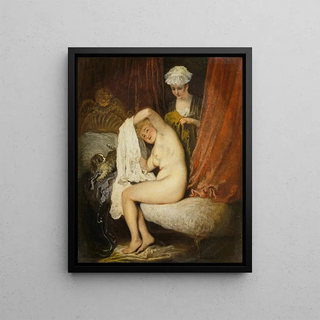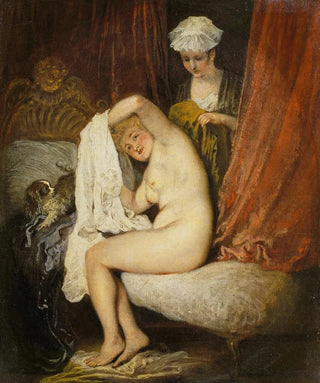Art print | A woman at her toilette - Jean-Antoine Watteau


View from behind

Frame (optional)
In the delicate universe of the 18th century, the artwork "Une femme à ses toilettes" by Jean-Antoine Watteau stands out as an emblematic masterpiece of Rococo. This painting, imbued with grace and sensuality, transports us to an intimate moment where the woman, the central figure, prepares herself with care. Through this tableau, Watteau captures not only physical beauty but also the very essence of femininity, blending elegance and introspection. The composition, bathed in soft light and pastel colors, invites us to contemplate the delicacy of the moment and to appreciate the subtle interaction between the artist and her model.
Style and uniqueness of the work
Watteau's style is distinguished by his innovative approach to themes and techniques. In "Une femme à ses toilettes," he employs a visual language filled with lightness and poetry. The graceful curves of the female silhouette, combined with flowing drapery, create a dreamlike atmosphere. The choice of colors, ranging from tender pinks to calming blues, contributes to the overall harmony of the art print. Watteau excels in suggesting rather than imposing, leaving room for the viewer's imagination. The scene, both intimate and universal, evokes feelings of tenderness and contemplation, thus reinforcing the singularity of his style. Every detail, from the mirror reflecting the woman's beauty to the dimmed light caressing the surfaces, testifies to the technical mastery and artistic sensitivity of the creator.
The artist and his influence
Jean-Antoine Watteau, an emblematic figure of the Rococo movement, profoundly marked art history with his unique approach and his ability to capture fleeting emotions. Born in 1684 in Valenciennes, he managed to establish himself in Paris, where he found inspiration in everyday life and human interactions. His work goes beyond simple representation; it explores the nuances of life, pleasures, and melancholies. Watteau influenced many artists, both contemporaries and future generations, by introducing a new sensibility into painting. His style, characterized

Matte finish

View from behind

Frame (optional)
In the delicate universe of the 18th century, the artwork "Une femme à ses toilettes" by Jean-Antoine Watteau stands out as an emblematic masterpiece of Rococo. This painting, imbued with grace and sensuality, transports us to an intimate moment where the woman, the central figure, prepares herself with care. Through this tableau, Watteau captures not only physical beauty but also the very essence of femininity, blending elegance and introspection. The composition, bathed in soft light and pastel colors, invites us to contemplate the delicacy of the moment and to appreciate the subtle interaction between the artist and her model.
Style and uniqueness of the work
Watteau's style is distinguished by his innovative approach to themes and techniques. In "Une femme à ses toilettes," he employs a visual language filled with lightness and poetry. The graceful curves of the female silhouette, combined with flowing drapery, create a dreamlike atmosphere. The choice of colors, ranging from tender pinks to calming blues, contributes to the overall harmony of the art print. Watteau excels in suggesting rather than imposing, leaving room for the viewer's imagination. The scene, both intimate and universal, evokes feelings of tenderness and contemplation, thus reinforcing the singularity of his style. Every detail, from the mirror reflecting the woman's beauty to the dimmed light caressing the surfaces, testifies to the technical mastery and artistic sensitivity of the creator.
The artist and his influence
Jean-Antoine Watteau, an emblematic figure of the Rococo movement, profoundly marked art history with his unique approach and his ability to capture fleeting emotions. Born in 1684 in Valenciennes, he managed to establish himself in Paris, where he found inspiration in everyday life and human interactions. His work goes beyond simple representation; it explores the nuances of life, pleasures, and melancholies. Watteau influenced many artists, both contemporaries and future generations, by introducing a new sensibility into painting. His style, characterized






